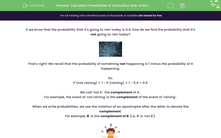If we know that the probability that it's going to rain today is 0.4, how do we find the probability that it's not going to rain today?

That's right! We recall that the probability of something not happening is 1 minus the probability of it happening.
So,
P (not raining) = 1 - P (raining) = 1 - 0.4 = 0.6
We call 'not A' the complement of A .
For example, the event of 'not raining' is the complement of the event of 'raining'.
When we write probabilities, we use the notation of an apostrophe after the letter to denote the complement.
For example, B' is the complement of B (i.e. B' is 'not B').

Bear with us - this will be easier to understand once you start practising with the questions!
But now, what if we had more than just two events?
The table below shows the probabilities of drawing different coloured marbles from a bag:

| Colour | Probability |
|---|---|
| Red | 0.28 |
| Blue | |
| Green | 0.2 |
| Yellow | 0.13 |
How could we find the probability of drawing a blue marble?
Well, we know: P(blue) = 1 - P(not blue)
'Not blue' in this case means either red, green or yellow (those are the only other colours in the bag!)
This means that the P(not blue) is the probability of these added together!
P(not blue) = P(red) + P(green) + P(yellow) = 0.28 + 0.2 + 0.13 = 0.61
So we get that the probability of getting a blue marble is:
P(blue) = 1 - P(not blue) = 1 - 0.61 = 0.39
We could also rewrite this as all the probabilities having to add up to 1:
P(red) + P(blue) + P(green) + P(yellow) = 1

The probabilities will always add up to 1 as long as two conditions are met:
1) The events are mutually exclusive: they cannot happen at the same time.
For example, a marble can't be red and blue at the same time - the same way it can't rain and not rain at the same time!
2) The set of the events is exhaustive: there is no other option than these events.
For example, there were only red, blue, green and yellow marbles in the bag - we cannot possibly draw another colour (ie. there is no other option than those four colours!).
That was quite a few new phrases that we've learnt in this introduction, wasn't it?!
Don't worry, it's much easier putting this all into practice - let's have a go at that!
You can look back at this page at any point by clicking on the red help button on the screen.









